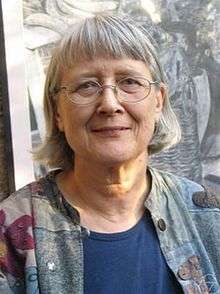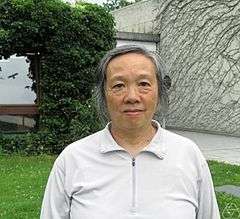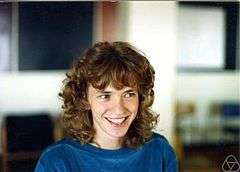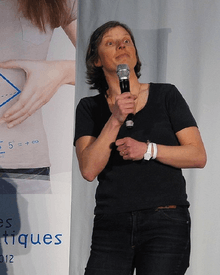Ruth Lyttle Satter Prize in Mathematics
The Ruth Lyttle Satter Prize in Mathematics, also called the Satter Prize, is one of twenty-one prizes given out by the American Mathematical Society (AMS).[1] It is presented biennially in recognition of an outstanding contribution to mathematics research by a woman in the previous six years.[2] The award was established in 1990 using a donation from Joan Birman, in memory of her sister, Ruth Lyttle Satter,[3] who worked primarily in biological sciences, and was a proponent for equal opportunities for women in science.[4] First awarded in 1991, the award is intended to "honor [Satter's] commitment to research and to encourage women in science".[5] The winner is selected by the council of the AMS, based on the recommendation of a selection committee.[5] The prize is awarded at the Joint Mathematics Meetings during odd numbered years, and has always carried a modest cash reward. Since 2003, the prize has been $5,000,[5][6] while from 1997 to 2001, the prize came with $1,200,[7][8] and prior to that it was $4,000.[9] If a joint award is made, the prize money is split between the recipients.[7]
| Ruth Lyttle Satter Prize in Mathematics | |
|---|---|
| Awarded for | outstanding contribution to mathematics research by a woman in the previous six years |
| Presented by | American Mathematical Society |
| Reward(s) | $5,000 |
| First awarded | 1991 |
| Currently held by | Maryna Viazovska (2019) |
| Website | www |
As of 2019, the award has been given 15 times, to 16 different individuals. Dusa McDuff was the first recipient of the award, for her work on symplectic geometry.[10] A joint award was made for the only time in 2001, when Karen E. Smith and Sijue Wu shared the award.[7] The 2013 prize winner was Maryam Mirzakhani, who, in 2014, was the first woman to be awarded the Fields Medal. This is considered to be the highest honor a mathematician can receive.[11][12] She won both awards for her work on "the geometry of Riemann surfaces and their moduli spaces".[13] The most recent winner is Maryna Viazovska, who was awarded the prize in 2019 for her "groundbreaking work in discrete geometry and her spectacular solution to the sphere-packing problem in dimension eight".[14]
The Association for Women in Science have a similarly titled award, the Ruth Satter Memorial Award, which is a cash prize of $1,000 for "an outstanding graduate student who interrupted her education for at least 3 years to raise a family".[15][16]
Recipients
| Year | Image | Recipient | Rationale |
|---|---|---|---|
| 1991 |  |
Dusa McDuff | "for her outstanding work during the past five years on symplectic geometry" |
| 1993 |  |
Lai-Sang Young | "for her leading role in the investigation of the statistical (or ergodic) properties of dynamical systems" |
| 1995 |  |
Sun-Yung Alice Chang | "for her deep contributions to the study of partial differential equations on Riemannian manifolds and in particular for her work on extremal problems in spectral geometry and the compactness of isospectral metrics within a fixed conformal class on a compact 3-manifold" |
| 1997 | .jpg) |
Ingrid Daubechies | "for her deep and beautiful analysis of wavelets and their applications" |
| 1999 | Bernadette Perrin-Riou | "for her number theoretical research on p-adic L-functions and Iwasawa theory" | |
| 2001 | Karen E. Smith | "for her outstanding work in commutative algebra" | |
 |
Sijue Wu | "for her work on a long-standing problem in the water wave equation" | |
| 2003 |  |
Abigail Thompson | "for her outstanding work in 3-dimensional topology" |
| 2005 | Svetlana Jitomirskaya | "for her pioneering work on non-perturbative quasiperiodic localization, in particular for results in her papers (1) Metal–insulator transition for the almost Mathieu operator, Ann. of Math. (2) 150 (1999), no. 3, 1159–1175, and (2) with J. Bourgain, Absolutely continuous spectrum for 1D quasiperiodic operators, Invent. Math. 148 (2002), no. 3, 453–463" | |
| 2007 | Claire Voisin | "for her deep contributions to algebraic geometry, and in particular for her recent solutions to two long-standing open problems: the Kodaira problem (On the homotopy types of compact Kähler and complex projective manifolds, Inventiones Mathematicae, 157 (2004), no. 2, 329–343) and Green's conjecture (Green's canonical syzygy conjecture for generic curves of odd genus, Compositio Mathematica, 141 (2005), no. 5, 1163–1190; and Green's generic syzygy conjecture for curves of even genus lying on a K3 surface, Journal of the European Mathematical Society, 4 (2002), no. 4, 363–404)" | |
| 2009 |  |
Laure Saint-Raymond | "for her fundamental work on the hydrodynamic limits of the Boltzmann equation in the kinetic theory of gases" |
| 2011 | Amie Wilkinson | "for her remarkable contributions to the field of ergodic theory of partially hyperbolic dynamical systems" | |
| 2013 |  |
Maryam Mirzakhani | "for her deep contributions to the theory of moduli spaces of Riemann surfaces" |
| 2015 |  |
Hee Oh | "for her fundamental contributions to the fields of dynamics on homogeneous spaces, discrete subgroups of Lie groups, and applications to number theory" |
| 2017 | Laura DeMarco | "for her fundamental contributions to complex dynamics, potential theory, and the emerging field of arithmetic dynamics" | |
| 2019 |  |
Maryna Viazovska | "for her groundbreaking work in discrete geometry and her spectacular solution to the sphere-packing problem in dimension eight. |
See also
References
- "Prizes and Awards". American Mathematical Society. Retrieved September 14, 2017.
- "Ruth Lyttle Satter Prize in Mathematics". American Mathematical Society. Retrieved September 13, 2017.
- Case, Bettye; Leggett, Anne, eds. (2005). Complexities: Women in Mathematics. Princeton University Press. p. 97. ISBN 0-691-11462-5.
- "Educational Awards: Ruth Satter". Association for Women in Science. Archived from the original on January 2, 2013. Retrieved September 14, 2017.
- "2017 Ruth Lyttle Satter Prize" (pdf). Notices of the AMS. American Mathematical Society. 64 (4): 316. April 2017.
- "2003 Satter Prize" (pdf). Notices of the AMS. American Mathematical Society. 50 (4): 474. April 2003.
- "2001 Ruth Lyttle Satter Prize" (pdf). Notices of the AMS. American Mathematical Society. 48 (4): 411–12. April 2001.
- "1997 Satter Prize" (pdf). Notices of the AMS. American Mathematical Society. 44 (3): 348. March 1997.
- "1995 Satter Prize" (pdf). Notices of the AMS. American Mathematical Society. 42 (4): 459. April 1995.
- Morrow, Charlene; Peri, Teri, eds. (1998). Notable Women in Mathematics: A Biographical Dictionary. Westport, Connecticut: Greenwood Press. p. 140. ISBN 0-313-29131-4.
- "Reclusive Russian turns down math world's highest honour". Canadian Broadcasting Corporation. AP. August 22, 2006. Retrieved September 13, 2017.
- "Maryam Mirzakhani, first woman to win maths' Fields Medal, dies". BBC News. July 15, 2017. Retrieved September 13, 2017.
- "Maryam Mirzakhani, First Woman and Iranian to Win Fields Medal, Dies at 40". The Wire. July 15, 2017. Retrieved September 13, 2017.
- "The Latest". American Mathematical Society. Retrieved March 5, 2020.
- "AAS Committee on the Status of Women". AASWOMEN. January 2004. Retrieved September 14, 2017.
- Austin, Ruth, ed. (1996). The Grants Register 1997. New York: Macmillan Press. p. 189. ISBN 978-0-312-15898-9.
- "Prizes and Awards". American Mathematical Society. Retrieved September 13, 2017.